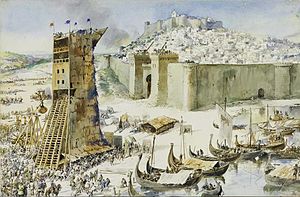
Back حصار لشبونة Arabic لیسبون موحاصیرهسی AZB Обсада на Лисабон Bulgarian Setge de Lisboa (1147) Catalan Obléhání Lisabonu Czech Belagerung von Lissabon (1147) German Toma de Lisboa (1147) Spanish محاصره لیسبون Persian Siège de Lisbonne (1147) French Toma de Lisboa Galician
| Siege of Lisbon | |||||||
|---|---|---|---|---|---|---|---|
| Part of the Portuguese Reconquista and the Second Crusade | |||||||
 The Conquest of Lisbon painting by Alfredo Roque Gameiro (1917) | |||||||
| |||||||
| Belligerents | |||||||
|
|
| ||||||
| Commanders and leaders | |||||||
|
Afonso I of Portugal Hervey de Glanvill Arnout IV, Count of Aarschot Christian of Ghistelles Simon of Dover Andrew of London Saher of Archelle William Longsword |
| ||||||
| Strength | |||||||
| ~15,000 | ||||||
The siege of Lisbon, from 1 July to 25 October 1147, was the military action against the Almoravid dynasty that brought the city of Lisbon under the definitive control of the new Christian power, the Kingdom of Portugal.
The siege of Lisbon was one of the few Christian victories of the Second Crusade—it was "the only success of the universal operation undertaken by the pilgrim army", i.e., the Second Crusade, according to the near contemporary historian Helmold,[3] although others have questioned whether it was really part of that crusade.[4] It is seen as a pivotal battle of the wider Reconquista.
The fall of Edessa in 1144 led to a call for a new crusade by Pope Eugene III in 1145 and 1146. In the spring of 1147, the Pope authorized the crusade in the Iberian Peninsula. He also authorized Alfonso VII of León and Castile to equate his campaigns against the Moors with the rest of the Second Crusade. In May 1147, a contingent of crusaders left from Dartmouth, Devon in the Kingdom of England. They had intended to sail directly to the Holy Land, but weather forced the ships to stop on the Portuguese coast at the northern city of Porto on 16 June 1147. There they were convinced to meet with Afonso I of Portugal, who had in 1139 declared himself king of the new Kingdom of Portugal.
The crusaders agreed to help the King attack Lisbon, with a solemn agreement that offered to the crusaders the pillage of the city's goods and the ransom money for expected prisoners. The siege began on 1 July. The city of Lisbon at the time of arrival consisted of sixty thousand families, including the refugees who had fled Christian onslaught from neighbouring cities of Santarém and others. Also reported by the De expugnatione Lyxbonensi is that the citadel was holding 154,000 men, not counting women and children; as the medieval account put it, after 17 weeks of siege "the inhabitants were despoiled and the city cleansed".
The rulers of Lisbon agreed to surrender on 24 October, four months later, primarily because of hunger within the city. Most of the crusaders settled in the newly captured city, but some of the crusaders set sail and continued to the Holy Land. Lisbon eventually became the capital city of the Kingdom of Portugal in 1255.
- ^ Lowney, Christopher (2012-12-04). A Vanished World: Medieval Spain's Golden Age of Enlightenment. Simon and Schuster. p. 107. ISBN 978-0-7432-8261-1.
- ^ H. V. Livermore (2 January 1966). A New History of Portugal. Cambridge University Press Archive. p. 57. GGKEY:RFTURZQG9XA.
- ^ C. W. David, "The Authorship of the De Expugnatione Lyxbonensi", Speculum, 7:1 (1932), 50, citing Helmold's Chronica Slavorum in MGH, Scriptores, 11, 58: Hoc solum prospere cessit de universo opere, quod peregrinus patravit exercitus.
- ^ West, 2013